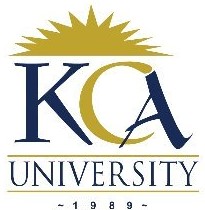 UNIVERSITY EXAMINATIONS: 2016/2017
UNIVERSITY EXAMINATIONS: 2016/2017
EXAMINATION FOR THE DEGREES OF BACHELOR OF SCIENCE IN
INFORMATION TECHNOLOGY/ APPLIED COMPUTING
BIT2301A BAC3206 COMPUTER GRAPHICS
FULLTIME/ PART TIME
SUPPLEMENTARY/ SPECIAL EXAMINATIONS
DATE: JULY, 2017 TIME: 2 HOURS
INSTRUCTIONS: Answer Question One & ANY OTHER TWO questions.
QUESTION ONE [30 MARKS]
a) Explain the concept of computer graphics (2 Marks)
b) What is OpenGL? Write OpenGL commands that can used to generate a POINT, LINE and
POLYGON structures. (6 Marks)
c) An RGB raster system is to be designed using an 8 inch x 10 inch screen with a resolution
of 100 pixels per inch in each direction
i) Calculate the amount of storage in megabytes needed for the frame buffer in order to
store 6 bits/pixel in the frame buffer (4 Marks)
ii) Differentiate between emissive and non-emissive flat panel displays and give an
example of each (4 Marks)
d) Briefly explain each of the following study domains and for each show how it relates to
computer graphics
i) Pattern Recognition
ii) Computer Vision
iii) Image Processing
iv) Information Visualization (8 Marks)
e) General light sources are difficult to work with because we must integrate light coming from
all points on the source. Briefly explain three types of simple light sources that can be
modeled in computer graphics (6 Marks)
QUESTION TWO [20 MARKS]
a) Define the terms:
i) Computer animation (2 Marks)
ii) Keyframe (2 Marks)
iii) In-between frame (2 Marks)
b) Describe three ways that animation in computer graphics can be developed (8 Marks)
c) Describe the specular and diffuse types of reflection in computer graphics (6 Marks)
QUESTION THREE [20 MARKS]
a) List any FOUR objects that are defined in the OpenGL toolkit. (4 Marks)
b) Rasterization and the display of real-world objects are key concepts in computer graphics.
i) Explain the differences between a general graphics system designed for a
programmer and one designed for a specific application, such as architectural design
(4 Marks)
ii) Determine how long it would take to load a 24 -bits-per-pixel frame buffer of a
resolution of 1280 by 1024 at a transfer rate of 105
seconds (4 Marks)
iii) Determine the scan rate in lines per second for each pixel row on a raster system with
a resolution of 1280 x 1024 and a refresh rate of 60 frames/second (4 Marks)
c) Distinguish between additive and subtractive color models (4 Marks)
QUESTION FOUR [20 MARKS]
a) Using an appropriate graphics programming language, write statements to accomplish the
following;
i) Set the color of a display window to light gray using RGB color (2 Marks)
ii) Set the size of rendered points to be 5 pixels wide (2 Marks)
iii) Specify a 420 by 620 window in the top left corner of the display (3 Marks)
b) Discuss FIVE usability considerations when building a graphical user interface (5 Marks)
c) Explain the effect of the following standard transformations
i) Skewing (2 Marks)
ii) Translation (2 Marks)
iii) Scaling (2 Marks)
iv) Reflection (2 Marks)
QUESTION FIVE [20 MARKS]
Often, we display functions of the form y = f(x,z) by displaying rectangular mesh generated by
the set of values {f(xi,zj)} evaluated at regular intervals in x and z. Hidden-surface removal
should be applied because parts of the surface can be obscured from view by other parts.
Required:
Derive two algorithms, one using hidden-surface removal and the other using hidden-line
removal, to display such a mesh. (20 Marks)